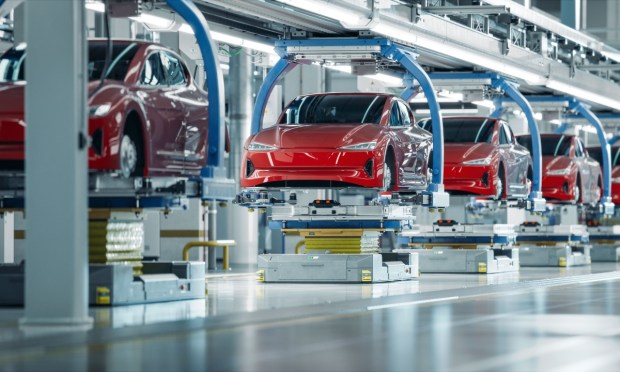
In the automotive industry, Q2 2024 brought a blend of triumphs and trials for the major players. As traditional automakers and innovative disruptors alike navigate a landscape marked by rapid technological advancement and shifting consumer preferences, their quarterly performances offer a snapshot of broader industry trends.
From Tesla’s record-breaking revenue to Carvana’s soaring sales, each company’s strategies and outcomes reflect their efforts to adapt and excel amid a backdrop of market volatility and evolving demands. This roundup delves into the latest developments from Tesla, General Motors, Ford, Stellantis and Carvana, providing insights into their achievements, challenges and future outlooks as they steer through this year.
In Q2, the automotive industry saw varied performances from major players, reflecting both progress and challenges.
Tesla set new records with $25.5 billion in revenue, a 2% year-over-year increase, driven by energy storage deployments and higher regulatory credit revenues. Despite a modest increase in vehicle deliveries and slowing growth, Tesla’s expansion into new vehicle trims and advancements in full self-driving technology underscore its focus on long-term innovations. The company is anticipating slower vehicle volume growth in 2024, shifting emphasis to new product launches and autonomous technologies.
Tesla CEO Elon Musk reflected on the current state of the electric vehicle (EV) market, noting a period of intense adoption followed by a subsequent slowdown.
“We saw large adoption and acceleration of EVs and then a bit of a hangover as others struggled to make compelling EVs,” Musk said, acknowledging that while many new EVs have entered the market, they have underperformed and resorted to substantial discounts, creating challenges for Tesla.
Musk remained confident in the future of electrification.
“EVs are best for customers and that the world is headed for a fully electrified transport, not just the cars, but also aircraft and boats,” he noted.
Looking forward, Tesla is set to introduce a more affordable model in the first half of next year, with Musk adding, “while others are pursuing different parts of the AI robotics stack, we’re pursuing all of them.”
General Motors (GM) reported a 7.2% increase in revenue, reaching $48 billion, with net income of $2.9 billion. The automaker saw a notable 40% rise in U.S. EV deliveries, outpacing industry growth. GM, however, faced stock declines and a 29% drop in sales in China, reflecting regional market challenges. The company continues to invest in its Cruise autonomous vehicle technology and aims to improve operational efficiency and public charging infrastructure.
GM Chairman and CEO Mary Barra noted the trajectory of EV sales.
“We’re going to bring additional capacity online in a measured cadence. This will enable us to better optimize our battery chemistry and form factors to meet our customers’ needs on cost and range,” Barra said.
Ford achieved a 2.9% revenue increase to $47.8 billion, with net income of $1.8 billion. The company saw a 34% surge in hybrid sales and improved its full-year free cash flow outlook. Ford’s “Ford+” strategy — which focuses on value creation in the era of electric and connected vehicles — emphasizes the company’s customer-centric improvements. Despite challenges, Ford remains a strong player in the hybrid and EV markets and is focused on enhancing vehicle efficiency and reducing costs.
Ford CEO Jim Farley pointed to the advantages of electric vehicles (EVs), noting that “about 50% of customers who buy automobiles would be better served on buying an electric vehicle.”
The company acknowledged misconceptions about EV costs and stresses that “OEMs like Ford must do a much better job in educating our customers about the advantages that an EV offers in terms of cost of ownership.”
Stellantis had a challenging second quarter, incurring a significant 48% drop in net profit, totaling $6 billion, and a 14% revenue decrease to $92 billion.
Meanwhile, U.S. sales sank 21% year-over-year. The company attributed its difficulties to excessive inventory, high R&D costs and operational inefficiencies, particularly in North America. Stellantis is addressing these issues with a planned launch of 20 new models and a commitment to its Dare Forward 2030 strategy, aiming to improve efficiency and market position.
Stellantis CEO Carlos Tavares described the second quarter as “disappointing and humbling,” citing three main factors for the setback: excessive R&D, CapEx and M&A expenses; internal operational flaws; and ineffective marketing strategies, especially in the U.S. market.
“We have significant work to do, especially in North America, to maximize our long-term potential,” Tavares said.
He said the company is addressing these issues and preparing for a “product blitz,” with 20 new models as part of a significant transformation effort. He noted the company’s financial performance “was driven principally by lower volumes and mix,” attributing this to inventory reduction, temporary production gaps from a generational portfolio transition and decreased market share, especially in North America.
Online used car retailer Carvana reported a 33% year-over-year increase in retail unit sales as it focuses on operational efficiency and its vertically integrated model.
Carvana’s business model, which emphasizes vertical integration and customer-centric solutions, remains a key differentiator. The company has invested approximately $10 billion in the past 10 years in building its eCommerce platform, including fulfillment and reconditioning capabilities, 360-degree vehicle photography and a proprietary financing platform. This investment allows Carvana to offer a seamless customer experience.
As Carvana continues to expand its inventory and logistics capabilities, it aims to become the largest and most profitable automotive retailer, the company said, with a goal of buying and selling millions of cars per year.
“From the perspective of one year ago, it would have been very hard for a reasonable person to believe we had any realistic chance of hitting those goals,” according to the company’s second-quarter shareholder’s letter. “Luckily, our team is ambitious enough to not be reasonable. We believe the differentiation in our customer offering and our application of custom-built technology relative to the industry uniquely position us to continue taking market share. Today we are in the best position that we ever have been.”